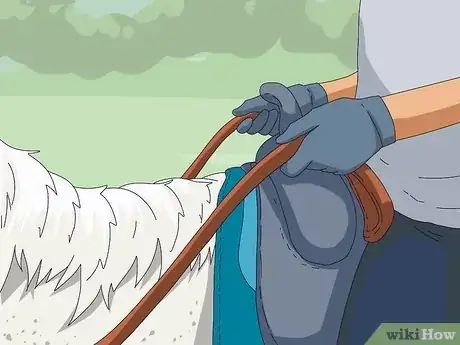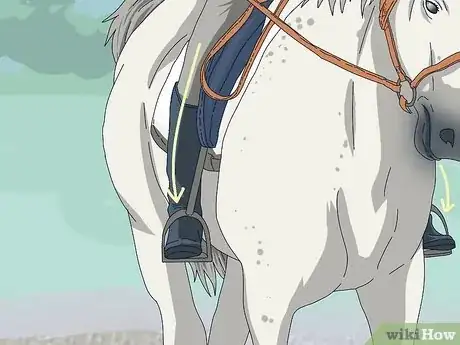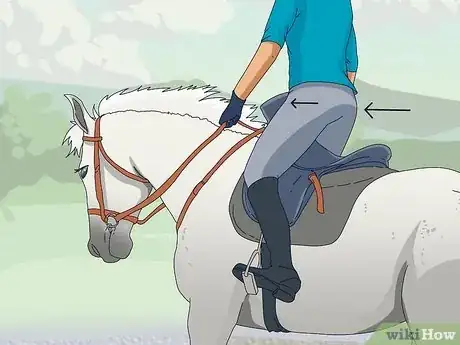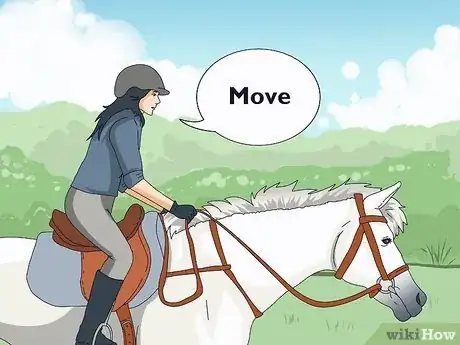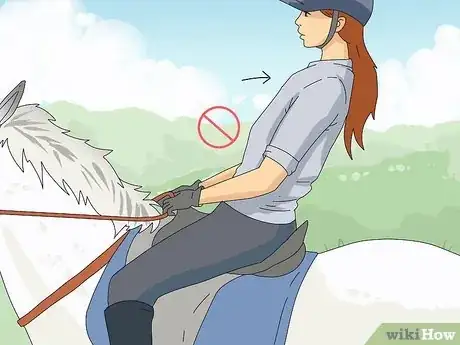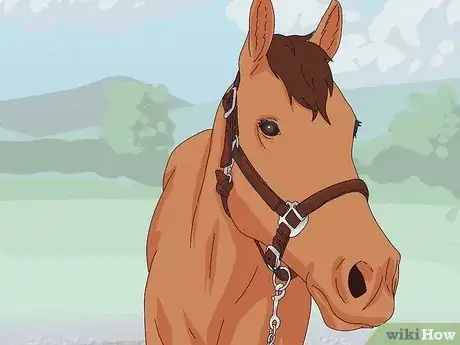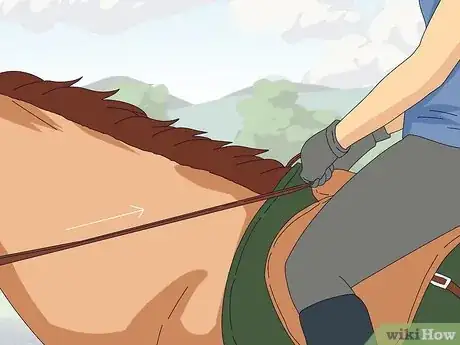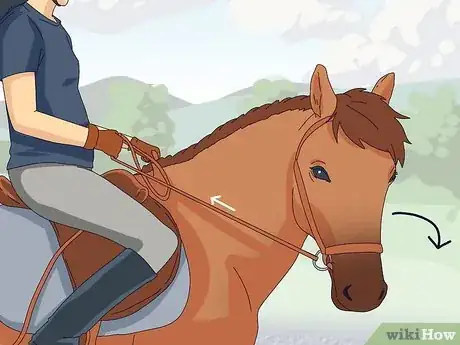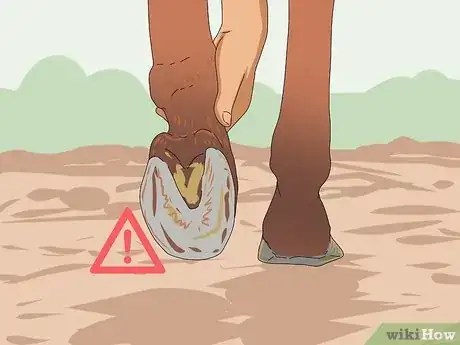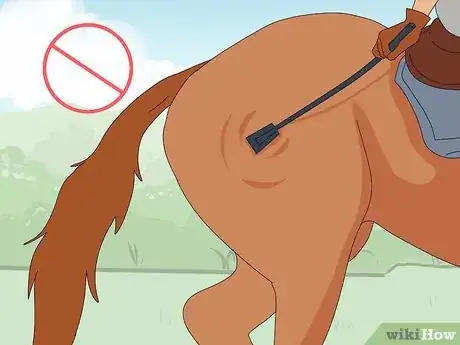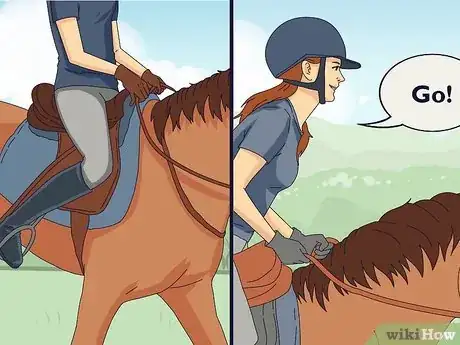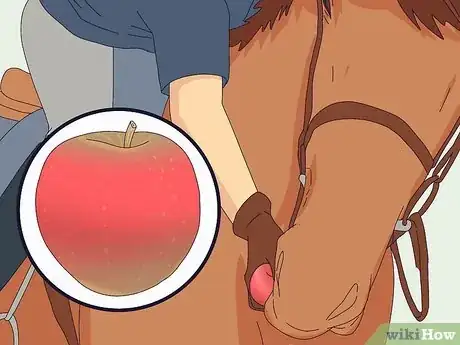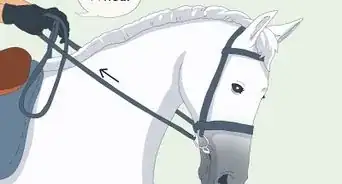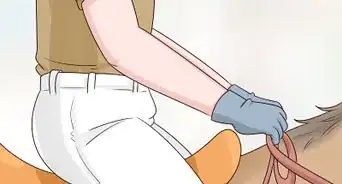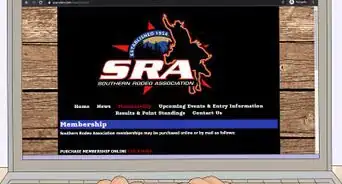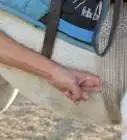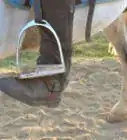This article was co-authored by Alana Silverman. Alana Silverman is a Certified EAGALA (Equine Assisted Growth and Learning Association) Equine Specialist and the Assistant Manager of Paddock Riding Club, a 200-horse premier equestrian facility based in Los Angeles, California. Alana has over 25 years of experience caring for and riding horses and specializes in English riding and riding instruction. She has a BA in Psychology from the University of Arizona.
There are 7 references cited in this article, which can be found at the bottom of the page.
This article has been viewed 85,587 times.
Getting a horse to move forward requires an understanding of how to communicate clearly with horses. If you can give a horse clear directions and not give it mixed messages, most horses will move willingly. However, if you have a horse that is unusually stubborn, you may need to use some creative solutions to get it to move where you want it to go.
Steps
Giving Commands While on Horseback
-
1Get the horse's attention by pulling on the reins. Before any physical cues are given, use the reins to put light tension on the horse's mouth. This light pulling will get the horse to pay attention to your cues.[1]
- Then, once you have the horse's attention, release your tension on the reins in order to reinforce other cues for forward movement.
-
2Grip the horse with your legs to cue it to go forward. While riding a horse, squeezing it with your legs is the signal that it should move forward. A well-trained horse will respond to this movement immediately. When you squeeze the horse with your legs, make sure you keep your legs straight and squeeze with your calves.[2]
- If you ride Western style, you can also lift the reins up and forward towards the horse's head while you do this.
- This hug with the legs should be quick and positive, not painful.
Advertisement -
3Push your hips forward in the saddle. You may need to give the horse some mental inertia by rocking forward in the saddle as you give it other cues to move forward. Moving forward in your seat just helps persuade the horse that it should start moving.
- Make sure this motion is done with your hips by pushing them down and forward. Don't use your upper body, as the horse can't feel those movements as clearly.
-
4Give a verbal cue that the horse should go forward. In addition to physical cues, it can help to let a horse know it's time to move with sound. Make a short clicking or kissing noise that will let the horse know its time to get going.
- Make this sound just once or twice, as doing it repeatedly can get your horse to go into trot or canter. You want the horse to start off gently, not at great speed.
- You can also give cues that are short words, such as "go" or "move." However, most horse riders use a short click or kissing noise instead.
-
5Give clear commands. Don't create any barriers that keep the horse from moving forward. Are you pulling the reins back or leaning back while asking the horse to move forward? Assess your body language to make sure you aren't sending confusing cues to the horse.[3]
- For example, don't push backward with your saddle at all while instructing the horse to go forward. This can happen accidentally if you are leaning forward with your shoulders instead of your hips.
- Horses are incredibly sensitive animals and can tell where you're looking and where you want to go. Keep your focus on where you want to go so the horse can read the subtleties of your body position.
Directing a Horse From the Ground
-
1Attach a leader to your horse's halter. To move a horse forward while on the ground, also called "leading in hand," you should have a halter on the horse and you should have a leader or reins attached to it. This will give you proper control of the animal and will allow you to communicate with it effectively.[4]
- If you are using reins to direct the animal, position them below the horse's head. If they are kept behind the horse's head, along its neck, communication through gentle tugs will be difficult and you will have a harder time holding onto the animal if it spooks and tries to bolt.
-
2Hold the leader or reins solidly. If you want to make a horse move forward while on the ground, it's important to hold onto the animal tightly, as the leader and reins are tools used to communicate with the horse and the way you can keep a hold of the animal.[5]
- However, do not wrap the leader or reins around your hand. This can lead to serious injury to your hand if the horse tries to run off.
-
3Tug the reins or leader in the direction you want it to go. Apply pressure so that the horse knows you want it to move. However, you should not have to pull with all your might. The tugging you do is just a cue for the horse.[6]
- A well-trained horse should start moving with just a gentle tug.
-
4Release pressure once the horse begins moving. Since tugging on the leader or reins is used simply as a cue, it's important to stop doing it once the horse responds to the cue. If you don't, it may be confusing for the horse. Continued pressure tells the horse that your desired action has not yet been completed.[7]
-
5Give verbal commands to the horse. As you cue the horse with the leader or reins, also use verbal cues to give it reinforcement for the movement you want it to do. This can be the same verbal cue you use when riding the horse, as then it becomes a universal cue for forward movement.
- Some verbal cues you could use include the words "go" or "forward."
- Many people use a short clicking noise to tell a horse that you want it to move. However, you may have a special noise you use if you are moving your own horse.
EXPERT TIPAlana Silverman is a Certified EAGALA (Equine Assisted Growth and Learning Association) Equine Specialist and the Assistant Manager of Paddock Riding Club, a 200-horse premier equestrian facility based in Los Angeles, California. Alana has over 25 years of experience caring for and riding horses and specializes in English riding and riding instruction. She has a BA in Psychology from the University of Arizona.Certified EAGALA Equine Specialist
 Alana Silverman
Alana Silverman
Certified EAGALA Equine SpecialistOur Expert Agrees: To properly develop vocal cues, use repetition and pairing, and start from the ground. For instance, when you're getting the horse out of the stall, you might click to the horse to indicate that it's time to move. Also keep in mind that when you're lunging the horse, you should use the same vocal cues that you plan to use when you're riding.
Getting a Stubborn Horse to Move Forward
-
1Check the horse's health. In some cases, resistance to moving forward is caused by the horse being in pain. If it is painful when the horse steps, it will decide to avoid that movement whenever possible. So, do a thorough assessment of its health yourself. You can also get your veterinarian to look the horse over as well.[8]
- Common injuries that can make a horse resistant to moving include problems with its hooves or its leg muscles.
-
2Use alternative movements to get where you need to go. Start moving the horse in a different direction if your horse won't move straight forward. Try backing up the horse and then having it move forward. You could move the horse in a different direction and then gradually turn it in the direction you originally wanted to go.[9]
- For example, tighten the reins on one side to make your horse turn its head. While doing that, tighten your calves around the horse and ask it to move forward. At first, make the horse move in small circles. Then, reduce the pressure on the reins a little bit, just enough to make the circles a little bigger. Gradually, you can release the rest of the tension on the reins and straighten out the horse.
- Once your horse becomes more willing to go straight, give it the command to go forward. This will reinforce that the command is associated with that type of movement.
-
3Avoid using excessive punishment. There are some people who say that we must show horses "who's boss." However, horses are amazingly smart and they pick up on clear and compassionate discipline better than brute force. For instance, instead of lashing out in anger when a horse misbehaves, apply moderate pressure with your legs to redirect a horse and stand your ground until the horse falls in line. [10]
- A good rule of thumb is to avoid doing anything to your horse that causes it pain or injury, even if the pain is only temporary.
- It is better to use repetition and positive reinforcement to get a horse to follow your commands. You will have a much easier time if you train a horse kindly rather than scaring it into submission.
-
4Do repeated training sessions. Continue training until your horse will reliably move forward when asked. If you have a very stubborn horse, you may need many of these sessions to train it to go forward when you want it to. Ideally, this process will teach both you and your horse good habits.[11]
- If your your horse doesn't go forward right when you direct it to, then use your legs to tap its body. Once the horse starts moving, halt it completely. Once the horse is at a stand still, again direct it to move forward. Do this repeatedly until the horse's response improves.
- If your horse is particularly stubborn, you can stop the horse and make it wait until it gets bored and then have him go on.
-
5Coax the horse with treats. If you really need a horse to get moving, such as if there is an emergency, you can lure it with a snack. However, this should be used rarely, as the horse may begin to expect a treat whenever you want it to move.
- Some good treats to feed a horse include most fruits, such as small pieces of banana, apple, or melon. You can also give it small pieces of carrot, celery, and snow peas.[12]
Community Q&A
-
QuestionCan a donkey be ridden?
 Community AnswerYes, donkeys can be ridden. In poor countries around the world donkeys are ridden, and also used as beasts of burden and for pulling carts.
Community AnswerYes, donkeys can be ridden. In poor countries around the world donkeys are ridden, and also used as beasts of burden and for pulling carts. -
QuestionHow do I get a horse to move out of her stall?
 StarHorseCommunity AnswerAttach a lead rope on the halter. Make sure that you are in front of the horse. Then, click your tongue and pull on the lead rope. If that doesn't work, try pulling harder. Then, if the horse still doesn't come, slap her on the shoulder, but not too hard.
StarHorseCommunity AnswerAttach a lead rope on the halter. Make sure that you are in front of the horse. Then, click your tongue and pull on the lead rope. If that doesn't work, try pulling harder. Then, if the horse still doesn't come, slap her on the shoulder, but not too hard. -
QuestionCan I just say "trot" to get a horse to trot?
 Community AnswerNo, you cannot unless your horse is very well trained. Try using whistles and foot commands.
Community AnswerNo, you cannot unless your horse is very well trained. Try using whistles and foot commands.
Warnings
- Always be cautious and careful when riding a horse.⧼thumbs_response⧽
- Wear proper safety equipment, such as a helmet.⧼thumbs_response⧽
References
- ↑ http://www.charleswilhelm.com/single-post/2014/01/23/Light-Hands
- ↑ https://horseandrider.com/trail-riding/creative-control-clear-cues
- ↑ https://horseandrider.com/trail-riding/creative-control-clear-cues
- ↑ https://practicalhorsemanmag.com/training/correct-safe-26802
- ↑ https://practicalhorsemanmag.com/training/correct-safe-26802
- ↑ https://practicalhorsemanmag.com/training/correct-safe-26802
- ↑ https://www.equisearch.com/riding-and-training/body-language-basics-your-horse-17030
- ↑ https://horseandriderbooks.wordpress.com/2015/03/11/fix-the-horse-that-refuses-to-go-forward-tips-from-heather-smith-thomas-to-beat-the-balk/
- ↑ https://horseandriderbooks.wordpress.com/2015/03/11/fix-the-horse-that-refuses-to-go-forward-tips-from-heather-smith-thomas-to-beat-the-balk/
About This Article
To make a horse move forward, start by lightly pulling on the reins to get its attention. Next, quickly squeeze the sides of the horse with your calves to signal that it should move forward. If the horse doesn’t start moving immediately, try pushing your hips down and forward to rock the saddle and give the horse some encouragement. Additionally, make a clicking or kissing noise, or say, “Go,” so the horse knows it’s time to move. For advice on how to get a stubborn horse to move forward, keep reading!
